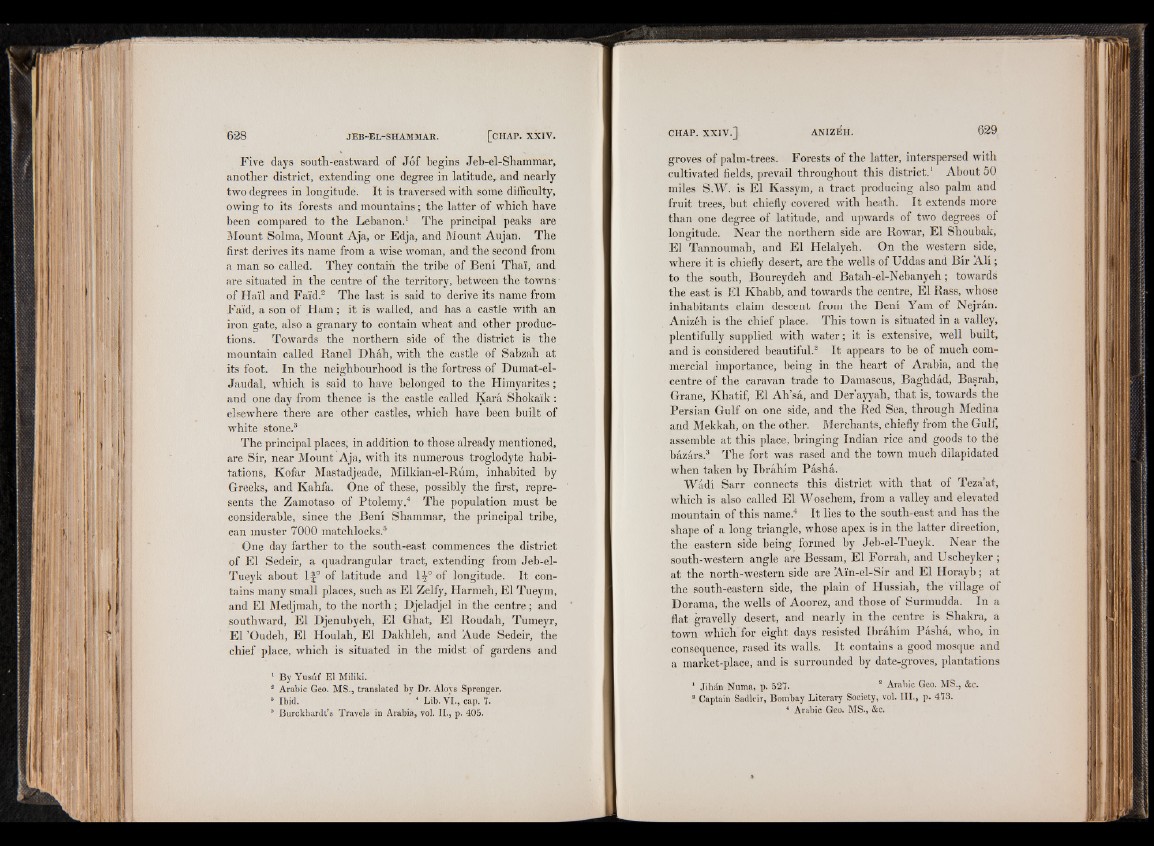
Five days south-eastward of Jof begins Jeb-el-Shammar,
another district, extending one degree in latitude, and nearly
two degrees in longitude. It is traversed with some difficulty,
owing to its forests and mountains ; the latter of which have
been compared to the Lebanon.1 The principal peaks are
Mount Solma, Mount Aja, or Edja, and Mount Aujan. The
first derives its name from a wise woman, and the second from
a man so called. They contain the tribe of Beni Thaï, and
are situated in the centre of the territory, between the towns
of Haïl and Faïd.2 The last is said to derive its name from
Fai'd, a son of Ham ; it is walled, and has a castle with an
iron gate, also a granary to contain wheat and other productions.
Towards the northern side of the district is the
mountain called Ranel I)hah, with the castle of Sabzah at
its foot. In the neighbourhood is the fortress of Dumat-el-
Jaudal, which is said to have belonged to the Himyarites ;
and one day from thence is the castle called Kara Shokaïk :
elsewhere there are other castles, which have been built of
white stone.3
The principal places; in addition to those already mentioned,
are Sir, near Mount Aja, with its numerous troglodyte habitations,
Kofar Mastadjeade, Milkian-el-Rum, inhabited by
Greeks, and Kahfa. One of these, possibly the first, represents
the Zamotaso of Ptolemy.4 The population must be
considerable, since the Beni Shammar, the principal tribe,
can muster 7000 matchlocks.5
One day farther to the south-east commences the district
of El Sedeir, a quadrangular tract, extending from Jeb-el-
Tueyk about I f 0 of latitude and 1^° of longitude. It contains
many small places, such as El Zelfy, Harmeh, El Tueym,
and El Medjmah, to the north ; Djeladjel in the centre ; and
southward, El Djenubyeh, El Ghat, El Roudah, Tumeyr,
El ’Oudeh, El Houlah, El Dakhleh, and Aude Sedeir, the
chief place, which is situated in the midst of gardens and
1 By Yusûf El Miliki.
3 Arabic Geo. MS., translated by Dr. Aloys Sprenger.
3 Ibid. 4 Lib. VI., cap. 7.
groves of palm-trees. Forests of the latter, interspersed with
cultivated fields, prevail throughout this district.1 About 50
miles S.W. is El Kassym, a tract producing also palm and
fruit trees, but chiefly covered with heath. It extends more
than one degree of latitude, and upwards of two degrees of
longitude. Near the northern side are Rowar, El Shoubak,
El Tannoumah, and El Helalyeh. On the western side,
where it is chiefly desert, are the wells of Uddas and Bir A li;
to the south, Boureydeh and Batah-el-Nebanyeh; towards
the east is El Khabb, and towards the centre, El Rass, whose
inhabitants claim descent from the Beni Yam of Nejran.
Anizeh is the chief place. This town is situated in a valley,
plentifully supplied with water; it is extensive, well built,
and is considered beautiful.2 It appears to be of much commercial
importance, being in the heart of Arabia, and the
centre of the caravan trade to Damascus, Baghdad, Basrah,
Grane, Khatif, El Ah’sa, and Der’ayyah, that is, towards the
Persian Gulf on one side, and the Red Sea, through Medina
and Mekkah, on the other. Merchants, chiefly from the Gulf,
assemble at this place, bringing Indian rice and goods to the
bazars.3 The fort was rased and the town much dilapidated
when taken by Ibrahim Pasha.
Wadi Sarr connects this district with that of Teza’at,
which is also called El Woschem, from a valley and elevated
mountain of this name.4 It lies to the south-east and has the
shape of a long triangle, whose apex is in the latter direction,
the eastern side being formed by Jeb-el-Tueyk. Near the
south-western angle are Bessam, El Forrah, and Uscheyker ;
at the north-western side are Ai'n-el-Sir and El Horayb; at
the south-eastern side, the plain of Hussiah, the village of
Dorama, the wells of Aoorez, and those of Surmudda. In a
flat gravelly desert, and nearly in the centre is Shakra, a
town which for eight days resisted Ibrahim Pasha, who, in
consequence, rased its walls. It contains a good mosque and
a market-place, and is surrounded by date-groves, plantations
1 Jihdn Numa, p. 527. ! Arabic Geo. MS., &c.
3 Captain Sadleir, Bombay Literary Society, vol. III., p. 473.
4 Arabic Geo. MS., &c.